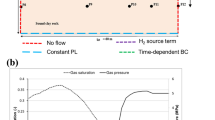Abstract
One of the major issues in the safety of a deep geological repository (DGR) for radioactive waste is the migration of hydrogen (H2) resulting mainly from anaerobic metal corrosion and from water and waste radiolysis. The migration of hydrogen may have adverse effects on the mechanics of the host rock and of the engineered barrier systems within a DGR. Some studies pointed out involvement of hydrogen “piston effect” in the transport of radionuclides. In this mechanism, the gas phase displaces the contaminated water, along backfilled but still relatively permeable drifts, towards the main shafts. The precise quantification of such a displacement is still a challenging task because it involves simulations at the scale of a DGR and only few studies were dedicated to this subject. In this work an attempt has been made to verify, through a simplified DGR model, if the usual parametrizations could give rise to a substantial and continuous water movement during the first 100,000 years after the closure of a DGR, when a significant H2-flux reaches its main drift. The assessment of the piston effect importance, related to the H2 production and release, is evaluated in terms of cumulative liquid-phase travel distance (CLTD) within the main drift and its persistence in time. Scenarios simulated by our model show that, in the investigated conditions, piston effect is not negligible (i.e., CLTD-values are greater than 100 m) and that water would be displaced towards the main shafts. However, this work is focused on the mechnisms involved, and the results obtained cannot therefore be genralized to any disposal concept. Furthermore, additional studies are necessary for improving this model by analyzing uncertainty propagation in its parameters, and by considering, e.g., gas-entry pressure and hysteresis phenomena usually neglected in the simulation models.












Similar content being viewed by others
References
Amri A, Saâdi Z, Ababou R, Dymitrowska M (2019) Réévaluation du modèle physique de transfert de l'hydrogène pour l'étude du transitoire hydraulique-gaz dans un stockage profond de déchets radioactifs. Poster presentation. In: Journée des thèses IRSN, La Grande Motte, 01–04 April 2019, France
ANDRA (2005) Evaluation de la faisabilité du stockage géologique en formation argileuse. Dossier 2005 Argile. https://www.andra.fr/sites/default/files/2017-12/266.pdf
Brommundt J, Kaempfer ThU, Enssle CP, Mayer G, Wendling J (2014) Full-scale 3D modelling of a nuclear waste repository in the Callovo–Oxfordian clay. Part 1: thermo-hydraulic two-phase transport of water and hydrogen. In: Norris S, Bruno J, Cathelineau M, Delage P, Fairhurst C, Gaucher EC, Höhn EH, Kalinichev A, Lalieux P, Sellin P (eds) Clays in natural and engineered barriers for radioactive waste confinement, vol 400. Geological Society, Special Publications, London, pp 443–467. https://doi.org/10.1144/SP400.34
Dymitrowska M, Smaï F, Bourgeat A (2015) Thermodynamic modelling of hydrogen migration in argillite for a deep geological radioactive waste repository—IRSN contribution to FORGE. Geol Soc Lond Spec Publ 415(1):167–188. https://doi.org/10.1144/SP415.13
Enssle CP, Brommundt J, Kaempfer ThU, Mayer G, Wendling J (2012) 3D Modeling of the long-term behavior of a large geological repository for HLW and ILW-LL nuclear waste, considering heat, gas, and radionuclide release and transport—optimizations that allow for detailed large-scale modeling. In: Proceedings of the TOUGH symposium 2012, Berkeley, CA
Enssle CP, Brommundt J, Kaempfer ThU, Mayer G, Wendling J (2014) Full-scale 3D modelling of a nuclear waste repository in the Callovo–Oxfordian clay. Part 2: thermo-hydraulic two phase transport of water, hydrogen, 14C and 129I. In: Norris S, Bruno J, Cathelineau M, Delage P, Fairhurst C, Gaucher EC, Höhn EH, Kalinichev A, Lalieux P, Sellin P (eds) Clays in natural and engineered barriers for radioactive waste confinement, vol 400. Geological Society, Special Publications, London, pp 469–481. https://doi.org/10.1144/SP400.35
Kaempfer ThU, Mishin Y, Brommundt J, Roger J, Treille E, Hubschwerlen N (2014) Extension and tuning of TOUGH2-MP EOS7R for the assessment of deep geological repositories for nuclear waste: hydrogen, arbitrarily long decay chains, and solubility limits. Nucl Technol 187(2):131–146
Luckner L, van Genuchten MTh, Nielsen DR (1989) A consistent set of parametric models for the flow of immiscible fluids in the subsurface. Water Resour Res 25:2187–2193
Millington RJ, Quirk JM (1961) Permeability of porous solids. Trans Faraday Soc 57(7):1200–1207
Mualem Y (1976) A new model for predicting the hydraulic conductivity of unsaturated porous media. Water Resour Res 12:513–522
Poller A, Enssle CP, Mayer G, Croisé J, Wending J (2011) Repository-scale modeling of the long-term hydraulic perturbation induced by gas and heat generation in a geological repository for high level and intermediate-level radioactive waste: methodology and example of application. Transp Porous Media 90:77–94. https://doi.org/10.1007/s11242-011-9725-x
Pruess K, Oldenburg C, Moridis G (1999) TOUGH2 user’s guide, version 2.0. LBNL-43134, Earth Sciences Division, Lawrence Berkeley National Laboratory, University of California, Berkeley
Saâdi Z, Dymitrowska M, Pan L, Deleruyelle F, Mokni N, Marsal F (2018) A simplified mechanistic model for studying the impact of hydrogen ‘piston effect’ on water displacement in a deep geological repository for radioactive waste. TOUGH Symposium 2018, 8–10 October 2018, Berkeley, USA, Extended abstract, p 5
van Genuchten MTh (1980) A closed-form equation for predicting the hydraulic conductivity of unsaturated soils. Soil Sci Soc Am J 44:892–898
Wendling J, Yu L, Treille E, Dymitrowska M, Pellegrini D, Ahusborde E, Jurak M, Amaziane B, Caro F, Genty A, Poskas P, Justinavicius D, Sentis M, Norris S, Bond A, Leung H, Calder NJ (2013) Final report on benchmark studies on repository-scale numerical simulations of gas migration. Part 1: cell scale benchmark. European Commission FORGE Deliverable D1.6-R
Wendling J, Justinavicius D, Sentis M, Amaziane B, Bond A, Calder NJ, Treille E (2019) Gas transport modelling at different spatial scales of a geological repository in clay host rock. Environ Earth Sci 78:221. https://doi.org/10.1007/s12665-019-8230-3
Author information
Authors and Affiliations
Corresponding author
Additional information
Publisher's Note
Springer Nature remains neutral with regard to jurisdictional claims in published maps and institutional affiliations.
Rights and permissions
About this article
Cite this article
Saâdi, Z., Dymitrowska, M., Deleruyelle, F. et al. An evaluation model of the impact of hydrogen ‘piston effect’ on water displacement in a deep geological disposal of radioactive waste. Environ Earth Sci 79, 434 (2020). https://doi.org/10.1007/s12665-020-09166-1
Received:
Accepted:
Published:
DOI: https://doi.org/10.1007/s12665-020-09166-1




